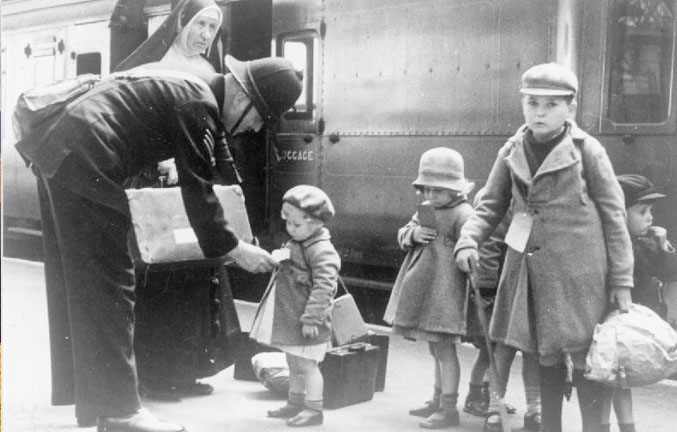E-Newsletter Signup
For special offers, updates and news of new products join our newsletter.
- Also in Blogs
- Sustainable Camping: Preserving Nature for Future Generations
- Embracing the Renewal of Spring: Camping Adventures Await.
- Beating The Winter Blues!
- The History of Cycling
- Senior Camping: Young at Heart
- View all posts in this category >>
GUEST BLOGGER
If you would like to contribute to our blog as a guest and can bring fresh outdoor experiences, please:
The English Countryside: Home for WWII Evacuees
Posted in Blogs on 7th November 2022
During World War II, the English countryside became home to around 3.5 million children and vulnerable people who had been evacuated from inner-city areas, such as London, to escape the air raids.
Many found new homes on campsites, where accommodation was provided to keep families together. Other children were sent to live with local people in the rural community, who had volunteered to offer a safe home as part of the war effort.
Many evacuees from London were fleeing the horrific bombings of the Blitz, when the German Luftwaffe launched continual night raids over the capital between 7th September 1940 and 11th May 1941.

© Imperial War Museums
Operation Pied Piper
The mass evacuations of major cities including London, Birmingham and Glasgow was officially known as Operation Pied Piper. While most evacuees stayed in the English countryside, especially on farms in quiet areas such as East Anglia and Kent, others were sent to live in Wales.
The idea behind Operation Pied Piper was to remove vulnerable people from areas where there was a higher risk of bombing – London was a major strategic target for the German bomber planes. Apart from being Britain’s capital city and nerve centre of the government, it was also the first major city in the south of England. This made it an easier target for Luftwaffe pilots flying across the Channel from Europe.
How did campsites help?
Finding accommodation for 3.5 million people presented massive logistical challenges for the government. However, after war broke out in September 1939, the importance of campsites became apparent, as they could provide temporary homes for many of the people fleeing the bomb raids.
It wasn’t only children who were evacuated. The government included hundreds of thousands of other vulnerable adults in the programme. This included mums with children under five, pregnant women, disabled people, teachers, and other helpers.
In the first two days after the war began on 1st September, around 1.5 million people were evacuated from cities into the countryside, travelling mainly by train. Caravan owners were asked to help the war effort to offer a home for the fleeing evacuees. They answered the rallying call, realising the importance of their caravan as a temporary home.
Some city-dwellers who had a mobile caravan decided to temporarily relocate to the countryside themselves to live on a campsite during the war. They simply put as many belongings as possible into their car and caravan and set off for rural areas.
Campsite owners voluntarily offered their services, permitting families to live on their site free of charge during the war. They were advertised as the safest homes in war time because they weren’t on the major routes for the Luftwaffe air raids and had no strategic buildings that were being targeted.
The public’s love of camping and caravan holidays had grown during the 1930s. Little did the campsite and caravan-owners know they would be providing a life-saving service for people during the war.
Caravan Club
The Caravan Club, an organisation that promoted holiday and leisure breaks in peacetime, had seen a boom in membership in the decade leading up to World War II. It was a cheap holiday, especially for people with children who wanted them to enjoy some countryside fresh air.
Petrol rationing at the outbreak of the war had put an end to social camping trips, leaving campsites and caravans all over the UK free to be used as temporary homes.
For surviving bomb victims who had been left homeless, living in a caravan gave them a chance to start rebuilding their life. As more families became homeless during the Blitz, increasing numbers of people fled to the countryside and caravan sales rocketed.
How did the industry respond?
The Caravan Club took on a new purpose during WW2, providing advice and practical support for people who were unfamiliar with living on a campsite. It helped evacuees feel like they were home and safe. Manufacturers quickly constructed more caravans in their thousands to cope with a continual influx of bomb victims.
The Caravan Club published a magazine providing advice to help people survive the war. While the countryside was relatively safe compared to cities, even caravan dwellers had to adhere to safely rules, such as blacking out the windows to stop chinks of light being visible to enemy aircraft after dark.
The Blackout had begun on 1st September 1939 and continued during the war. Evacuees who had been rehomed in caravans were also advised to camouflage the vehicle, using paint, netting and branches, so it would be harder for Luftwaffe pilots to see them from the air.
How comfortable were the evacuees?
While every step was taken to make campsites comfortable, the caravans were sparse compared with their modern counterparts. Generally manufactured as a short-term summer holiday home in warm weather, they were not insulated.
Some owners insulated their caravans with a modified wall lining and installed a stove. This helped the evacuees stay warmer and healthier, as condensation inside the caravan was reduced. Without insulation and a stove, it was reported some of the caravans were so cold on a winter’s night that condensation on inner walls had frozen during the night.
The BBC’s 2005 series, People’s War, spoke to former WW2 evacuees about their memories. One interviewee, Alec Gaskin, of Edgware, recalled how he and his mother lived in a caravan on a farm in Ivinghoe, a rural village in Buckinghamshire, during the war, while his father continued to work in London.
During the harsh winter of 1940/41, the young Alec caught pneumonia after severe snow blocked the roads and stopped food supplies from getting through. Telegraph lines were down due to the snow and Alec became seriously ill.
Arthur, the farmer’s son, saved Alec’s life by driving miles in his tractor to Tring, along almost impassable roads. He was able to collect some medication from a chemist, which Alec later admitted had saved him. The family moved into the farmhouse until the youngster was well again. They spent summer holidays in the caravan on the farm after the war.
Post-war camping
People’s wartime experiences of living on campsites in the countryside led to a post-war boom in camping holidays. After six years of the austerities of war, the British people were in need of a holiday. With money still being tight, a camping holiday was the cheapest way of having a change of scenery and enjoying fresh air.
World of Camping will be paying our respects to those who sacrificed their lives during times of conflict on Remembrance Sunday, 13th November, when a two-minute silence will be observed all over the world at 11 am.
Our thoughts and prayers will also be with those who continue to suffer in the Russia/Ukraine war.



